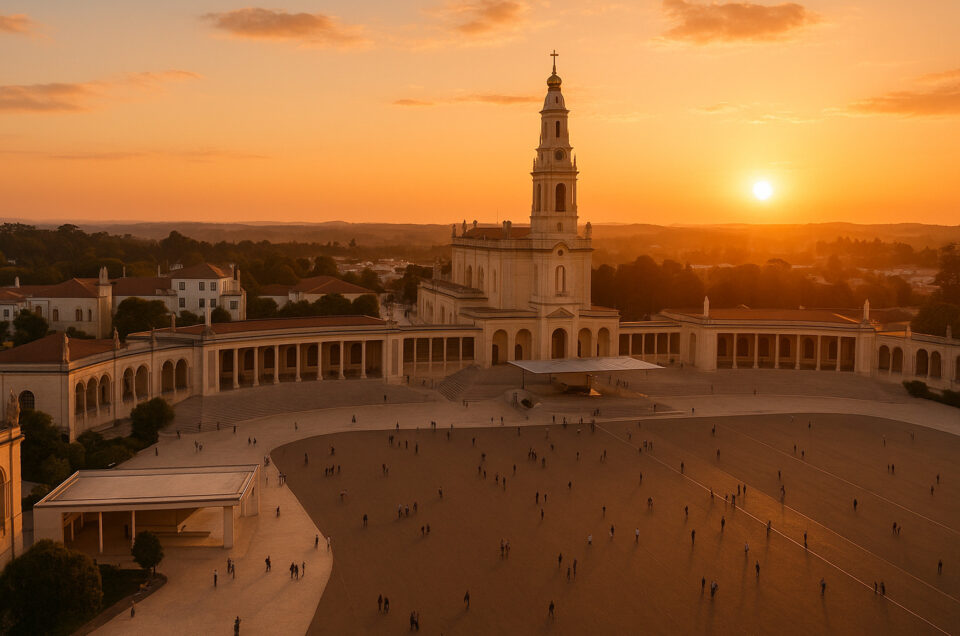Fátima, Portugal, is far more than a dot on the map—it’s a destination of deep faith, moving history, and profound peace. Every year, this sacred town in central Portugal draws millions of pilgrims and travelers from around the globe (including many from the United States) who come in search of inspiration and spiritual renewal. Even if you’re not a devout pilgrim, visiting Fátima offers a unique cultural experience: imagine standing in a vast plaza lit by thousands of candles, or walking the grounds where a miracle is said to have occurred. It’s an experience that touches the heart and stays with you long after you leave. Here are five compelling reasons to visit Fátima, blending its spiritual significance, cultural richness, and the comfort of modern travel services, to inspire your journey.
1. A World-Renowned Pilgrimage of Deep Spiritual Significance
Fátima is one of the most important Catholic pilgrimage sites in the world, on par with places like Lourdes and the Vatican. What makes it so special? In 1917, three young shepherd children in Fátima reported visions of the Virgin Mary (revered as Our Lady of Fátima), forever changing this once-sleepy village. In the century since, Fátima has become a beacon of faith and hope. Pilgrims from every corner of the earth travel here to pray for peace, seek healing, or fulfill vows of devotion. Many visitors—Catholic or not—describe a profound sense of peace upon arriving at the sanctuary. You can feel the devotion in the air: the gentle murmur of prayers, the glow of candles, and the sight of people from many nations united in reverence. For anyone interested in spirituality or religious culture, Fátima offers an uplifting, soul-stirring experience that truly lives up to its reputation. It’s not just history on display; it’s faith in action, and witnessing it can be deeply moving. Whether you come to strengthen your own faith or simply to observe this powerful devotion, Fátima’s spiritual energy is a compelling reason to visit.
Moreover, the global significance of Fátima is evident in the events and personalities drawn to it. Popes have journeyed to Fátima to pray – Pope John Paul II even credited Our Lady of Fátima with saving his life after an assassination attempt in 1981, placing the bullet from that incident in the crown of the Virgin’s statue as a token of gratitude. This connection to modern events underlines how revered Fátima is within the Catholic world. Even outside of major events, any day of the year you might find groups of pilgrims singing Ave Maria in unison or silently kneeling in prayer on the marble pathways. In Fátima, faith transcends language and nationality. The atmosphere is welcoming and inclusive – whether you consider yourself religious or simply curious, you’ll be greeted by the tranquil ambiance of a place where millions have left their burdens and hopes. Visiting Fátima is an opportunity to tap into this wellspring of spirituality that has touched so many lives worldwide.
2. The Sanctuary of Our Lady of Fátima: A Place of Peace and Reflection
At the heart of Fátima lies the magnificent Sanctuary of Our Lady of Fátima, a sprawling sacred complex that is both beautiful and serene. The moment you step onto the sanctuary grounds, you’ll notice a sense of calm. The centerpiece is an enormous open plaza (esplanade) capable of holding hundreds of thousands of pilgrims during major ceremonies. Even on quieter days, it’s a peaceful space perfect for reflection. Surrounding this plaza are several important holy sites that you can explore:
-
Basilica of Our Lady of the Rosary: A stunning neo-Baroque church with a tall central bell tower, this basilica is one of the sanctuary’s most iconic landmarks. Inside, you’ll find the tombs of the three visionary children — Lúcia dos Santos and her cousins, Saints Francisco and Jacinta Marto. Many visitors pay respects here, reflecting on how these humble shepherd children became central figures of a worldwide devotion. The basilica’s grand yet graceful architecture evokes a sense of reverence, and its gleaming white facade often contrasts beautifully with the blue Portuguese sky.
-
Chapel of the Apparitions (Capelinha das Aparições): This small open-air chapel marks the exact spot where the Virgin Mary is said to have appeared in 1917. Despite its modest size, it is truly the spiritual heart of Fátima. A statue of Our Lady of Fátima stands where the heavenly encounters occurred, and pilgrims gather around this chapel day and night. You might witness people silently praying the rosary, leaving flowers, or lighting candles. The simplicity of the Chapel of Apparitions, surrounded by pilgrims in quiet devotion, can be incredibly moving — it feels intimate, knowing you are at the very ground zero of the Fátima story.
-
Basilica of the Most Holy Trinity: In contrast to the old basilica, this is a modern basilica completed in 2007 to accommodate Fátima’s ever-growing number of visitors. Its contemporary design is striking yet austere, with clean lines and a bright, welcoming interior. With a seating capacity of over 8,000 people, it’s one of the largest Catholic churches in the world. During major pilgrimages, it fills up with worshippers from many nations. At other times, visitors find it a quiet place to sit, meditate, or attend one of the services held here (often including international masses). The architecture itself is a reason to visit — it’s fascinating to see how modern design and sacred art come together in a way that still evokes contemplation and awe.
As you explore the sanctuary, you’ll also find other meaningful spots: a large candle lighting area where flames of prayer flicker (more on that later), a monument containing a piece of the Berlin Wall (symbolizing Fátima’s connection to prayers for freedom and peace during the Cold War), and statues and artwork depicting scenes of the apparitions. The entire complex is extremely well maintained, clean, and open to all. Benches and quiet corners invite you to sit and soak in the atmosphere. You might hear church bells ringing softly or choir hymns echoing during mass times. Even if you come simply as a tourist, the Sanctuary of Fátima offers a place of tranquility that lets you pause from the rush of travel. It’s a chance to experience the culture of Portuguese faith and hospitality up close — locals and pilgrims alike will smile or nod at you, embodying the gentle kindness that Fátima inspires. In a world of distractions, the sanctuary is a haven of peace, and that alone is a compelling reason to spend time here.
3. The Inspiring Story and History of the 1917 Apparitions
Visiting Fátima is also a journey back in time to one of the 20th century’s most extraordinary events. The story of the 1917 apparitions is a blend of history, faith, and cultural heritage that continues to fascinate people around the world. Imagine the scene: it’s the middle of World War I, and Portugal is experiencing social upheaval (a new secular government had recently challenged religious practices). In this turbulent era, three shepherd children — Lúcia, Francisco, and Jacinta, aged just 10, 9, and 7 — report seeing a beautiful lady from heaven appear above an oak tree in the fields of Fátima. This happened not just once, but on six occasions between May and October 1917, always on the 13th of the month. The Lady (believed to be the Virgin Mary) entrusted the children with messages of prayer, penance, and peace, urging them to pray the rosary for the end of the war and for the world to turn back to God.
News of these miraculous apparitions spread quickly, and by the final apparition on October 13, 1917, a huge crowd of tens of thousands had gathered, hoping to witness a sign. That day gave Fátima its most famous miracle: the “Miracle of the Sun.” According to many testimonies, the sun appeared to spin, change colors, and dance in the sky, astounding those present – a phenomenon that reportedly left even skeptics awestruck. While scientists and historians may offer various interpretations of what happened, for believers it was a clear divine sign confirming the children’s message. This miracle and the humble faith of the three children put Fátima on the map of global consciousness. What had been an unknown village suddenly became a symbol of hope amidst chaos. The cultural impact was significant: at a time when people desperately needed something to cling to, the Fátima apparitions inspired millions to renew their faith. Over the next decades, devotion to Our Lady of Fátima spread worldwide – churches, schools, and even a famous Hollywood film (“The Miracle of Our Lady of Fatima” in 1952) brought the story to an international audience.
Walking through Fátima today, you become part of this continuing history. The very atmosphere holds echoes of 1917. You can visit the Monument of the Guardian Angel or the spot by the holm oak tree (a descendant of the original tree) where the visions occurred, imagining what it must have been like for those children surrounded by a crowd on that miraculous day. The nearby village of Aljustrel, just a short drive away, preserves the family homes of the three children, which you can visit to see the simple rural life they led. It’s humbling to stand in little Lucia’s bedroom or see the fields where the siblings played — it reminds you that these were real people, ordinary children chosen for an extraordinary role. Fátima’s story is not just a religious tale; it’s woven into the cultural and historical fabric of Portugal. The events of 1917 helped revive Catholic devotion in Portugal during a difficult time, and the shrine became a unifying national symbol of peace and hope. Today, more than a hundred years later, the legacy of Fátima is alive and well. By visiting, you don’t just learn about history — you feel it. Each prayerful whisper and each commemorative plaque around the sanctuary speaks to a miracle that, whether one believes it literally or not, undeniably changed the course of this community and touched the world. Experiencing Fátima’s history up close is both educational and inspirational, giving you a deeper appreciation for the endurance of faith and the resilience of a culture through time.
4. Unforgettable Pilgrimage Traditions and Experiences for Visitors
One of the most captivating reasons to visit Fátima is the chance to participate in its unique pilgrimage traditions and ceremonies. These experiences are not manufactured attractions; they are genuine expressions of faith and community that have been carried on for decades. Whether you’re a practicing Catholic or simply an observer, joining in these traditions can be profoundly moving and memorable.
-
Candlelight Processions: Imagine an evening in Fátima under a dark sky shimmering with thousands of tiny flames. The candlelight procession is perhaps the most iconic experience at Fátima. On many nights (especially from May through October, on the 12th and 13th of the month), pilgrims gather after sundown in the sanctuary plaza, each holding a lit candle. As the crowd sings hymns (often the gentle melody of “Ave Maria”) and prays the rosary in multiple languages, a statue of Our Lady of Fátima is carried through the assembly. The sea of candles moving in unison is a sight so beautiful and touching that it often brings tears to eyes of onlookers. You’ll feel a powerful sense of unity and peace, standing shoulder to shoulder with people from different nations, all connected by the light of faith and hope. Even if you don’t know the prayers, you are welcome to join the procession or simply watch from the sidelines. Many travelers say this nighttime vigil in Fátima is the highlight of their visit — an almost otherworldly encounter with the sacred.
-
Mass and Prayer Services: Attending a Mass in Fátima is another special experience. The sanctuary offers daily Masses in multiple languages (including English) to accommodate the international pilgrims. You might attend Mass in the open-air Chapel of the Apparitions, where the service has a cozy, intimate feel, or at one of the great basilicas for a larger, formal service with music echoing off the marble. There are also scheduled rosaries, Eucharistic adoration hours, and blessing ceremonies. Participating in these rites at Fátima—whether it’s a humble weekday Mass or a grand multi-lingual Sunday celebration—can deepen your appreciation of the site’s sanctity. Even those who aren’t Catholic often find the services peaceful and welcoming, as they are filled with messages of love, peace, and compassion. If you wish, you can also bring religious items (rosaries, medals, etc.) to have them blessed by a priest at Fátima, a meaningful keepsake of your journey.
-
Confession and Contemplation: Fátima is often called a shrine of reconciliation, and many visitors take the opportunity to go to confession here. The sanctuary has a dedicated Reconciliation Chapel with priests available to hear confessions in various languages. It’s heartening to know that if you seek this sacrament, you can likely speak to a priest in English (or your preferred language), as flags or signs usually indicate which language each confessor speaks. The act of confession in such a holy place can be a source of great comfort and spiritual renewal for believers. But even if confession isn’t something you plan to do, Fátima offers countless spots for quiet contemplation and personal prayer. You’ll notice some pilgrims walking on their knees along a special marble pathway that leads to the Chapel of the Apparitions — an intense act of devotion and penance carried out by those fulfilling a vow or seeking grace. Watching this, or perhaps trying a few steps on your own knees if you feel called to, is a humbling reminder of the depth of faith present here.
Beyond these, there are other experiences that make a visit special. You can light a candle at the sanctuary’s extensive candle racks — a simple act, yet deeply symbolic as you place your candle among thousands of others, each flame representing someone’s prayers. You can also explore the Via Sacra (Way of the Cross) path that winds from the sanctuary toward the tiny village of Valinhos, site of an angelic apparition and the Stations of the Cross, often walked by pilgrims seeking to connect with the sufferings and hopes of their faith. Throughout Fátima, the atmosphere encourages you to slow down and reflect. Even a non-religious visitor might find it soothing to sit on a bench and absorb the gentle choral music or the sound of a multitude praying quietly. In a world full of hustle, these traditions of Fátima allow you to experience something truly soulful and transcendent. They’re not just rituals to watch — they’re invitations to be part of a living pilgrimage, if only for a day, and that is an opportunity not to be missed.
5. Comfort and Ease: Private Tours, Transfers, and Expert Assistance
While Fátima’s spiritual and cultural appeal is clear, another reason to visit now is the sheer comfort and convenience with which you can make this journey – especially with the help of private tours and transfer services. International travelers, including many Americans, may wonder how to get to Fátima and navigate the experience smoothly. The good news is that Fátima is very accessible (about 130 km or a 90-minute drive north of Lisbon), and you can elevate your visit by choosing a custom private tour that handles all the logistics, allowing you to focus on the experience itself.
Private transfers from Lisbon and other cities: If you’re staying in Lisbon (or Porto, or elsewhere in Portugal), arranging a private transfer to Fátima is a game-changer. Instead of worrying about bus schedules or driving on unfamiliar roads, you can be picked up directly from your hotel or the airport by a professional, English-speaking driver. In around an hour and a half, you’ll be whisked in a comfortable, air-conditioned vehicle through the Portuguese countryside straight to Fátima. Companies like Portugal Magik offer luxury vehicles (e.g. Mercedes-Benz fleet) and courteous drivers/guides who are not only chauffeurs but also knowledgeable hosts. This means you can relax and even learn about Portuguese culture during the ride. If you’re coming from the United States or any long distance, imagine the relief of having a friendly face greet you and take care of your transportation — no stress about navigation or language barriers. By the time you arrive in Fátima, you’re rested and ready to absorb the spiritual atmosphere.
Custom private tours of Fátima (and surrounding regions): Opting for a private tour of Fátima transforms your visit into a personalized pilgrimage tailored to your interests and needs. Rather than following a strict group tour timetable, a private tour with an expert guide gives you flexibility. Want to attend the 11 AM English Mass at the sanctuary? Your guide will ensure you arrive in time. Feeling the need for an extra quiet moment at the Chapel of Apparitions or to light another candle? No problem — the schedule can adjust to you. The best tour guides are deeply familiar with Fátima’s history and significance; they’ll enrich your experience with stories and insights that you might miss if you went on your own. You’ll appreciate having someone by your side to point out subtle details (like the exact spot of the apparitions, or explaining the beautiful mosaics inside the modern basilica) and to answer any questions you might have about Catholic traditions or local customs. Surrounding regions can also be explored if you wish. With a custom tour, you could combine your Fátima visit with nearby cultural gems — for example, stopping by the stunning Batalha Monastery (a UNESCO World Heritage Gothic masterpiece) or the quaint medieval town of Óbidos on your way back. This way, you get a broader taste of Portugal’s heritage, all in one seamless trip.
On-the-ground assistance with spiritual activities: Perhaps one of the greatest benefits of a private tour service is the concierge-style assistance for all those special activities in Fátima. Unsure how to find the schedule for the candlelight procession or what time confessions are held in English? Your guide can take care of that. Reputable companies like Portugal Magik will help coordinate your visit so that you don’t miss the highlights. They can advise on Mass schedules, reserve a spot if needed (especially for groups or special Mass intentions), and guide you to the best area to stand during the evening procession for a great view. If you desire to go to confession, your guide can show you exactly where the Reconciliation Chapel is and when English-speaking priests are available, maybe even facilitate introductions if appropriate. Essentially, you have a local expert looking out for you, making sure all the pieces of your Fátima experience fall perfectly into place. This level of care is especially comforting for first-time visitors or older travelers who might worry about the practical details. With an experienced tour company handling the logistics, you’re free to immerse yourself fully in the moment — whether that’s praying without rush, taking photos at your leisure, or simply absorbing the atmosphere.
Traveling with comfort and ease doesn’t make your pilgrimage any less authentic; in fact, it can make it more meaningful. By removing the stress and hassle, a private tour lets you open your heart and mind to Fátima. You’ll leave not only with beautiful memories, but likely also with a sense of deep satisfaction and possibly spiritual fulfillment. In other words, reason #5 is about peace of mind: the kind of peace that perfectly complements the serenity of Fátima itself. When you know everything is taken care of – from transportation to timing – you can truly experience Fátima in all its grace. Many visitors have found that having a knowledgeable guide and private driver made their visit richer and more insightful than they ever expected. It’s like having a friend in Portugal who knows the way, opening doors (sometimes literally) to experiences you might not arrange on your own. If you’re planning to visit Fátima, especially from abroad, taking advantage of these services is a wise choice that ensures your “journey of faith” is also a comfortable journey.
Conclusion: Fátima is a destination that speaks to the mind, heart, and soul. From its inspirational spiritual presence and beautiful sanctuary, to its captivating history and living traditions, it offers something truly unique in the world of travel. These five reasons highlight why Fátima deserves a spot on your itinerary, but the true magic of Fátima can only be felt when you’re there in person — standing in the grand plaza at sunset, listening to the gentle murmur of prayers, or gazing at the stars as candles flicker all around. It’s an experience that can be deeply personal and yet universally touching.
Visiting Fátima in Portugal is more than just a day trip or a tourist stop; it’s a journey into a place of peace and hope that has the power to inspire and uplift. And with the convenience of private tours, transfers, and expert local guidance through companies like Portugal Magik, your visit can be as smooth and rewarding as possible. You can focus on what truly matters to you — be it prayer, reflection, or simply taking in the atmosphere — while every practical detail is handled with care. This level of support, combined with Fátima’s profound ambiance, ensures that your time in Fátima will be memorable for all the right reasons.
So, whether you’re a pilgrim at heart, a history enthusiast, or a traveler seeking meaningful moments, Fátima warmly invites you. Come and discover the sanctuary that has captivated millions. Allow yourself to be moved by the stories and the serenity. And perhaps, like so many before, you’ll leave Fátima with a nourished spirit and cherished memories — grateful for the experience and maybe even already planning to return. Safe travels and bom caminho (good journey) as you set out to visit Fátima, Portugal’s shining beacon of faith and peace!








